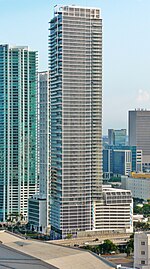1974 Miami DEA building collapse
1970s in Miami1974 disasters in the United States1974 in FloridaAugust 1974 events in the United StatesBuilding and structure collapses in the United States ... and 4 more
Disasters in FloridaDrug Enforcement AdministrationSource attributionUse mdy dates from July 2021
On August 5, 1974, at 10:24 a.m. EDT, a Federal office building housing the US Drug Enforcement Administration (DEA) Miami Field Division office in downtown Miami, Florida, United States, collapsed after the roof caved in, causing the deaths of seven DEA employees and injuries to 15 others.Initial speculation centered on a theory that the cars parked on a six-inch-thick slab of concrete on the roof were too heavy, causing the collapse. Investigations later concluded that resurfacing of the parking lot combined with salt in the sand had eroded the supporting steel structure of the building, weakening it catastrophically.
Excerpt from the Wikipedia article 1974 Miami DEA building collapse (License: CC BY-SA 3.0, Authors).1974 Miami DEA building collapse
I 395, Miami
Geographical coordinates (GPS) Address Nearby Places Show on map
Geographical coordinates (GPS)
| Latitude | Longitude |
|---|---|
| N 25.786 ° | E -80.191 ° |
Address
I 395 183
33132 Miami
Florida, United States
Open on Google Maps









